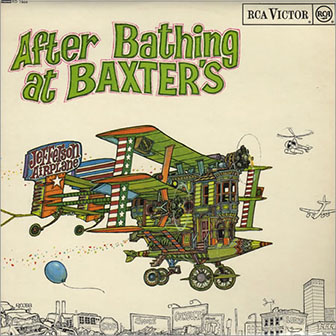After Bathing at Baxter's
Jefferson Airplane
℗ 1967 Victor Records LOP 1511 / © RCA Records

Jefferson Airplane opened 1967 with Surrealistic Pillow and closed it with After Bathing at Baxter's, and what a difference ten months made. Bookending the year that psychedelia emerged in full bloom as a freestanding musical form, After Bathing at Baxter's was among the purest of rock's psychedelic albums, offering few concessions to popular taste or the needs of AM radio, which made it not remotely as successful as its more accessible predecessor, but also a lot more daring. The album also showed a band in a state of ferment, as singer/guitarist Marty Balin largely surrendered much of his creative input in the band he'd founded and let Paul Kantner and Grace Slick dominate the songwriting and singing on all but one cut ("Young Girl Sunday Blues"). Essentially, After Bathing at Baxter's was the group's attempt to create an album that captured what the psychedelic experience sounded and felt like to them from the inside; on a psychic level, it was an introvert exercise in music-making and a complete reversal of the extrovert experience in putting together Surrealistic Pillow. Toward that end, they were working "without a net," for although Al Schmitt was the nominal producer, he pretty much gave the group the freedom to indulge in any experimentation they chose to attempt, effectively letting them produce themselves. The results were startlingly different from most of what was on their two prior LPs; there were still folk and blues elements present in the music, albeit mostly transmuted into something very far from what any folksinger or bluesman might recognize. Kantner, Jorma Kaukonen, and Jack Casady cranked up their instruments; Spencer Dryden hauled out an array of percussive devices that was at least twice as broad as anything used on the previous album; and everybody ignored the length of what they were writing and recording, or how lyrically they sang, or how cleanly their voices meshed. The group emerged four months later with one of the rawest, most in-your-face records to come out of the psychedelic era, and also a maddeningly uneven record, exciting and challenging in long stretches, yet also in other places very close to stultifyingly boring; delightful in its most fulfilling moments (which were many), but almost deliberately frustrating in its digressions, and amid all of that, very often beautiful. The nine-minute instrumental "Spare Chaynge" remains an acquired taste, a lot more aimless than, say, the extended jams left behind by the Quicksilver Messenger Service, though it did point the way toward what Kaukonen and Casady would aim for more successfully when they formed Hot Tuna, but most of the rest is indisputably among the more alluring musical experimentation of the period. Slick's "Rejoyce" is a bizarre yet eminently listenable adaptation of James Joyce's writings, and Kantner's "The Ballad of You & Me & Pooneil" and "Watch Her Ride," as well as Balin's "Young Girl Sunday Blues," proved that the group could still rock out with a beat, even if not so prettily or cleanly as before; "Martha" was one of their last folk-based excursions. After Bathing at Baxter's was represented poorly on CD until 1996, when it was finally remastered properly, though that remastered edition was later deleted and is only available in Ignition, a very expensive four-CD box. [Additionally, After Bathing at Baxter's was the last Jefferson Airplane album to appear in a mono version, which sounds very different from the more common stereo mix.] — Bruce Eder. |
- 1. The Ballad of You and Me and Pooneil [04:30]
- 2. A Small Package of Value Will Come to You Shortly [01:39]
- 3. Young Girl Sunday Blues [03:33]
- 4. Martha [03:26]
- 5. Wild Times [03:10]
- 6. The Last Wall of the Castle [02:40]
- 7. reJoyce [04:00]
- 8. Watch Her Ride [09:21]
- 9. Spare Chaynge [03:01]
- 10. Two Heads [03:09]
- 11. Won't You Try Saturday Afternoon [05:06]
Участие в альбоме:
- Marty Balin: rhythm guitar, vocals
- Jack Casady: bass
- Spencer Dryden: drums, percussion, horn arrangement
- Paul Kantner: rhythm guitar, vocals
- Jorma Kaukonen: lead guitar, sitar, vocals
- Grace Slick: piano, organ, recorder, vocals
- Gary Blackman: vocals
- Bill Thompson: vocals